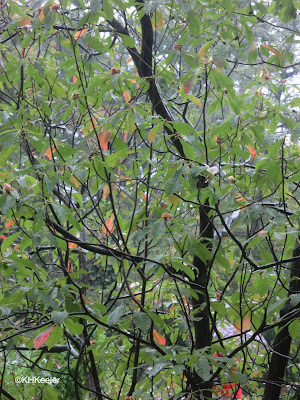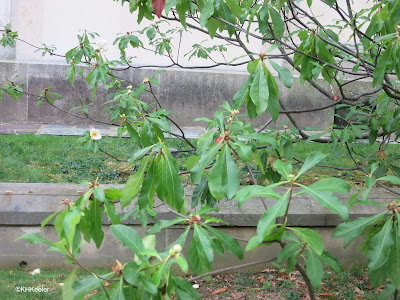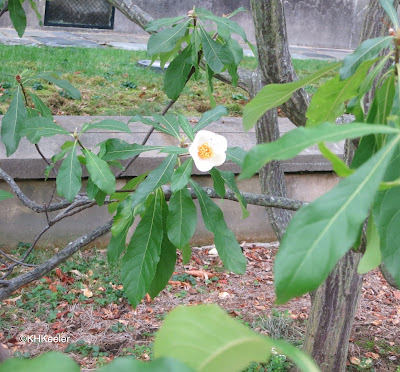Being from Colorado, my reaction was "so?" No franklinias in Colorado.
 |
| Franklinia alatamaha franklinia or the Franklin tree |
Actually, I had read about franklinia. It is the tree Franklinia alatamaha (camellia family Theaceae), native to the U.S. southeast. In The Founding Gardeners author Andrea Wulf described John Bartram finding this tree in the forests along the Alatamaha River in Georgia in 1765. Seeds were planted in the Bartram's gardens in Philadelphia and shared with gardeners such as George Washington.
In the 1750 and 1760s lots of American trees were new and exciting--eastern hemlock, tulip poplar, sugar maple. The trees of the Americas are different from the trees of Europe and settlers from Europe, their sense of independence increasing, were planting these new trees. Franklinia might have been just another of those, except that, although it was very attractive, it was rare and hard to grow. Today it is treasured because it is apparently extinct in the wild, having not been found since 1790.
And if people gave it a common name different from its scientific name, they'd likely call it the American camellia.
 |
| franklinia leaves in the rain |
The Bartrams, early and critically important commercial gardeners located in Philadelphia, recognized franklinia's uniqueness. Only three other members of the tea family, Theaceae, have been found in North America. In Asia trees in the tea family are beloved: for their beautiful flowers, known here as camellias (at least 3 species, Camellia japonica, C. reticulata, and C. sasanqua) but also for the essential traditional drink, tea, made from the leaves of Camellia sinensis, a close relative with tiny flowers. Franklinia is distinctive enough that it is classified in a genus with only the one species. Thus,franklinia is a unique, attractive American tree now extinct in the wild. Definitely worth trying to grow!
 |
| a bigger franklinia tree, with flower buds |
However what the Philadelphian gardeners, now and in the past, particularly liked was the name Franklinia. William Bartram named the tree for Benjamin Franklin.
I have an awkward relationship to Benjamin Franklin. We share a birthday, January 17. I started school in upstate New York. There, colonial and Revolutionary War history was very important. As a child, I was unimpressed by Franklin: an old man with a depressing 18th century hairstyle, famous for improving quotes such as
"Early to bed, early to rise, makes a man healthy, wealthy and wise."
"If time be of all things the most precious, wasting time must be the greatest prodigality."
"By failing to prepare, you are preparing to fail."
Stodgy!
 |
| franklinia |
Reading histories of the Revolutionary War period more recently, I find many places where Franklin's input was invaluable to the early development of the United States. Modern writers put his recognition of his illegitimate son in a positive light and Fart Proudly was satire. In addition he was a very successful businessman, a fine inventor (his credits include bifocals, swim fins and the Franklin stove) and a careful scientist, receiving lasting international fame for proving that lightning is electricity. (online biography)
On balance, Benjamin Franklin probably more than deserves a fine tree named after him and Philadelphia is right to be proud of it and him.
 |
| franklinia |
 |
| franklinia |
Several of my books listing the trees of North America did not list franklinia at all. No wonder I had never heard of it before reading about the Bartrams. I guess plants that are extinct in the wild are easy to omit from books on American trees. (Authors are always under pressure to keep their works short and so cheaper to produce.)
However, franklinia is available from nurseries and can be found growing across the U.S. (see Flora of North America) The Missouri Botanic Garden page describes how to grow it (link).
Comments and corrections welcome.
References
Prince, L. A. Franklinia alatamaha in Flora of North America link
Wulf, A. The Founding Gardeners. Vintage Press 2012.
Kathy Keeler
More at awanderingbotanist.com
Join me on Facebook: https://www.facebook.com/AWanderingBotanist

Hi My names Francis I knew about this plant, and found this searching after Discovering your posts , and BLOG searching camellia Online
ReplyDeleteFound this Link to be useful, (also has some seeds listed )
, and I you have the best pictures I've seen online so far !!! (why does every one just show the Flowers
I Liked the Wiry look of the tree
(By the way I was planing on starting seeds , but seeing your pictures I may Buy a plant (the cheapest I've seen was $8, so it's not that bad but these things can be expensive)
I think you should of mentioned (briefly) others native to the US though (Franklinia, Gordonia and Stewartia)
and a Intergeneric Hybrid X gordonia (a crossing of two different genus in the same family (like a Shipova (pear, and mountain ash for instance)
Didn't want to post a site, that may not be allowed
Delete(the vendor Link takes you to native seed network )
Thanks for the good Blog (i'm In Chicago("LAND") If your ever there check out the morton arboretum
http://www.wildflower.org/plants/result.php?id_plant=FRAL
Oops I forgot I know this is a Blog where others read
ReplyDeleteA Intergeneric Hybrid X gordonia is not a GMO A shipova a pyrus X sorbus was found over a 100 years ago (plants can cross if the chromosomes are the same (and the chance seedling grows or is found , and not destroyed or crossed by breeders )
Thanks for the great photos and little plant history lesson! I am growing Tee cantaloupe (C sinensis, variety Sochi) in Western Oregon, harvest and process the leaves, and dry the flowers for tea.
ReplyDeleteI'm also growing enjoyed mountain ash cross, this with Rowan (Ivan's Belle) with dark maroon berries.